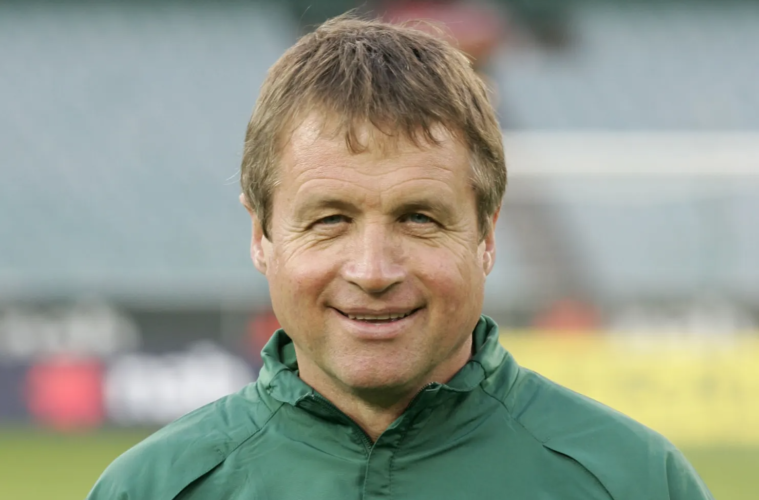Ron Smith arrived at South Melbourne in 1974 hoping to revive a playing career that had stalled in England. Injury prevented a proper return, but wouldn’t stop him leaving an indelible mark on Australian football. Within 25 years, Smith was an inaugural Australian Football Hall Of Fame inductee.
Ron Smith was just 25, but at a crossroads. He’d fallen short of the dream he’d harboured since his boyhood in Enfield, Essex, to play for Tottenham; he’d played for their youth side, but injuries and relative lack of size cost him the final step.
To that point he’d ‘just played football’, with ‘no understanding of the principles of the game.’ Although disappointed, he continued to play for the love of it with non-league clubs Borough Road College, Kingstonian and Southall.
With perspective, Smith would credit this period as his introduction to a coaching career that sustains him to this day. But at the time his football roots were still loose enough for he and his wife to chance their arm elsewhere.
‘I’d always fancied living in a warm climate where it didn’t rain every Saturday. You could also go out and do other things, so the attraction was too much and my wife and I decided we would go out to Melbourne’, Smith told Box2Box Offside.
‘We didn’t have a car in those days, so I needed to find a club that trained by the train line. At Middle Park there were Melbourne and South Melbourne Hellas – I rang up Sam Papasavas [at Hellas] and said ‘can I have a trial at your club? I think I’m good enough.’
The blistering return to form wasn’t to be but, within a year, Smith was Victoria’s State Director of Coaching. The FA coaching badges he’d acquired while with College were ‘quite rare, a ticket to opportunity’, and coupled with his teaching background, his coaching career was underway.
A rapid rise shot him to the first of many involvements with the Socceroos less than four years after his arrival. Jim Shoulder, a fellow Englishman who’d forged his playing career at Scarborough and Hartlepool in the early 1970’s, had been tasked with guiding Australia to the 1978 World Cup in Argentina.
Public expectation had arguably never been higher following the side’s maiden World Cup appearance in 1974. Through 26 matches Shoulder led the Socceroos through Oceanic qualifiers, but came unstuck in the final group of Iran, South Korea, Kuwait and Hong Kong.
‘Jimmy had taken a job in the ACT as a Director of Coaching and applied for the national team job. I don’t think he was serious but because of politics at the time… he finished up with it. He didn’t know many people and we’d done some work together, so when he got the job he rang me up and said ‘how would you feel about helping me with the national team?’
‘I said I’d be absolutely delighted, but we were criticised quite heavily by people in the media. Looking back I can understand that, but like most things in life, if an opportunity comes along you don’t say no.
‘The campaign was difficult, and came down to the odd goal here and there. We played in Iran in front of 100,000 people, and for many of the Aussie team it was their first time overseas. It really was an extension of what happened in 74’, it was a little tougher and maybe on another day we’d have qualified. We didn’t, but it was a great experience.’
Shoulder was dismissed at the end of the campaign, and Smith moved into his first job in senior management in Iceland with Keflavic in 1979. The pinnacle of Smith’s managerial career would later come in Malaysia, where he led Sabah from relegation-candidates to ‘M’ League Champions in under two seasons.
His greatest legacy in his adopted homeland would come as head of the AIS’ football programme from 1986-1996, where he played a guiding hand in the careers of thirteen eventual members of the Socceroos’ 2006 World Cup squad.
‘Vast and varied’ doesn’t do service to Smith’s contribution to Australian national teams. From 2004 he served Football Australia as a technical manager; in 2005 he was interim national team boss prior to Guus Hiddink’s appointment, and in 2008 he assisted Graham Arnold at the Olympics, to name a few.
‘I really enjoyed working for the national team. I was only part time, so when I worked for Guus, Pim and Holger, I was basically only working for three months of the year. During this period I did my PhD, so I was a full-time student with a few months during the year to put some theory into practice.
‘I was really deep into analysis and trying to work out how goals were scored, which was what was driving me at the time. It was an exciting time and one I look back on fondly.
‘It was a pleasure to work, not only for Guus, but for Pim, who was a lovely man. When I had a heart attack in 2009 I had a quadruple bypass, Pim rang me in hospital. He said ‘Ronnie, don’t worry about our next two matches, we’ll beat Qatar in a couple of weeks and have qualified.’
‘He said “you just make sure you get yourself fit to be able to come to South Africa”, and that meant a huge amount to me from my hospital bed at the time, and that’s what happened.’
At 73, Smith’s service to Australian football continues. Working as an assistant to National Technical Director Trevor Morgan and consultant to Football Australia, he credits his ‘thirst for knowledge’ as the driving force behind his longevity.
‘I look at football from slightly different eyes these days. The more you learn about the game and what players do, that really makes the difference. The question is, how do you get them to do it, and do they understand what they do? It’s that thirst for knowledge that keeps me so interested and involved in the game.’

